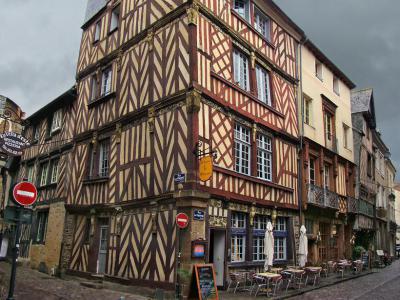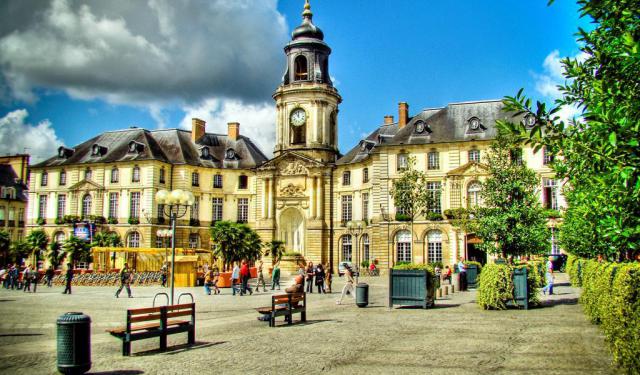Rue du Chapitre (Chapter Street), Rennes
Running east-west, between Calvary or Golgotha Square and Rue de Montfort, is Chapter Street. Previously, this street was known as Rue du Four-du-Chapitre for having been the place where an oven belonging to the Chapter of the Cathedral was located.
This area is a melange of architectural styles. Here, within a space of just a few square feet you can see centuries of architecture revealed in full splendour, including some rather curious old buildings, delightful to the eye.
The number of half-timbered houses still standing is quite remarkable, considering that the majority of them were built in the 17th century, before the Great Fire of 1720. Luckily, Rue du Chapitre was largely spared by fire thanks to the owner of the Hôtel de l'Escu de Runefaut, at no. 5, who had paid handsomely for having the neighbouring homes torn down, which ultimately prevented the fire from spreading further.
Built circa 1650, this hotel is a multi-coloured marvel with the façade painted in lively red and yellow ochre, a testimony to the fashion prevalent in the 17th century. Inside this hotel's courtyard is a pretty wooden staircase with turned balusters. In 1988, the building underwent restoration, with its original geometric effect recreated in the spirit of the period using the traces of polychromy discovered during excavations. On the ground floor, it has a tiny restaurant called Le Little Attic.
Other houses of note include the Hôtel de Talhouêt, at no. 3 – with two half-timbered floors and a long façade – extant since the 18th century, and first known as the Hôtel du Faouët and then the Hôtel de Villaudon.
At no. 6 is the splendid Hôtel de Blossac, the former residence of the commander-in-chief of the province, boasting a monumental entrance. Built on the site of the former outbuildings of the Hôtel de Brie, this mansion is an architectural marvel of the Age of Enlightenment. Transformed into a residential building in the 19th century, starting from 1977 it has been the headquarters of the Regional Department of Cultural Affairs.
At no. 8, the Hôtel de Brie or Bois de la Motte, dating from 1624, has a pilastered façade, styled as a mix of Classical and Renaissance.
At the corner of Rue de la Psalette and 22 Rue du Chapitre you will spot another beautiful Renaissance decoration. This parliamentarian’s house of the 16th century had an extra floor added in the 18th. Of a particular note here is an interesting detail: one of the corner panels was made from granite to prevent damage caused by cartwheels navigating tight corners.
This area is a melange of architectural styles. Here, within a space of just a few square feet you can see centuries of architecture revealed in full splendour, including some rather curious old buildings, delightful to the eye.
The number of half-timbered houses still standing is quite remarkable, considering that the majority of them were built in the 17th century, before the Great Fire of 1720. Luckily, Rue du Chapitre was largely spared by fire thanks to the owner of the Hôtel de l'Escu de Runefaut, at no. 5, who had paid handsomely for having the neighbouring homes torn down, which ultimately prevented the fire from spreading further.
Built circa 1650, this hotel is a multi-coloured marvel with the façade painted in lively red and yellow ochre, a testimony to the fashion prevalent in the 17th century. Inside this hotel's courtyard is a pretty wooden staircase with turned balusters. In 1988, the building underwent restoration, with its original geometric effect recreated in the spirit of the period using the traces of polychromy discovered during excavations. On the ground floor, it has a tiny restaurant called Le Little Attic.
Other houses of note include the Hôtel de Talhouêt, at no. 3 – with two half-timbered floors and a long façade – extant since the 18th century, and first known as the Hôtel du Faouët and then the Hôtel de Villaudon.
At no. 6 is the splendid Hôtel de Blossac, the former residence of the commander-in-chief of the province, boasting a monumental entrance. Built on the site of the former outbuildings of the Hôtel de Brie, this mansion is an architectural marvel of the Age of Enlightenment. Transformed into a residential building in the 19th century, starting from 1977 it has been the headquarters of the Regional Department of Cultural Affairs.
At no. 8, the Hôtel de Brie or Bois de la Motte, dating from 1624, has a pilastered façade, styled as a mix of Classical and Renaissance.
At the corner of Rue de la Psalette and 22 Rue du Chapitre you will spot another beautiful Renaissance decoration. This parliamentarian’s house of the 16th century had an extra floor added in the 18th. Of a particular note here is an interesting detail: one of the corner panels was made from granite to prevent damage caused by cartwheels navigating tight corners.
Want to visit this sight? Check out these Self-Guided Walking Tours in Rennes. Alternatively, you can download the mobile app "GPSmyCity: Walks in 1K+ Cities" from Apple App Store or Google Play Store. The app turns your mobile device to a personal tour guide and it works offline, so no data plan is needed when traveling abroad.
Rue du Chapitre (Chapter Street) on Map
Sight Name: Rue du Chapitre (Chapter Street)
Sight Location: Rennes, France (See walking tours in Rennes)
Sight Type: Attraction/Landmark
Guide(s) Containing This Sight:
Sight Location: Rennes, France (See walking tours in Rennes)
Sight Type: Attraction/Landmark
Guide(s) Containing This Sight:
Walking Tours in Rennes, France
Create Your Own Walk in Rennes
Creating your own self-guided walk in Rennes is easy and fun. Choose the city attractions that you want to see and a walk route map will be created just for you. You can even set your hotel as the start point of the walk.
Rennes Introduction Walking Tour
Rennes began its existence as Condate Redonum, a Gallic and Roman town at the confluence of the Ille and Vilaine rivers. During medieval times, it became one of the three major cities of Brittany, together with Vannes and Nantes. The city played an important role in the Stamped Paper Revolt in 1675. During the French Revolution, it became the headquarters of the republican army in the fighting... view more
Tour Duration: 2 Hour(s)
Travel Distance: 2.9 Km or 1.8 Miles
Tour Duration: 2 Hour(s)
Travel Distance: 2.9 Km or 1.8 Miles
Rennes Historical Churches Walking Tour
Historical churches occupy a significant place in the cultural identity of Rennes, France. Travelers with a keen interest in religious history and architecture will find plenty to look at in this town.
Standing out majestically among the local ecclesiastical landmarks is Rennes Cathedral. Built in the 12th century, it underwent a centuries-long transformation from its Gothic origins to its... view more
Tour Duration: 1 Hour(s)
Travel Distance: 2.1 Km or 1.3 Miles
Standing out majestically among the local ecclesiastical landmarks is Rennes Cathedral. Built in the 12th century, it underwent a centuries-long transformation from its Gothic origins to its... view more
Tour Duration: 1 Hour(s)
Travel Distance: 2.1 Km or 1.3 Miles
Medieval Houses Walking Tour
From the late Middle Ages through to the end of the Ancien Régime (the period of Bourbon rule in France, from 1589 to 1789), a multitude of half-timbered houses were built in Brittany, and particularly in Rennes. Even today, the Breton capital is where half-timbered houses remain the most prevalent style of architecture, and a key element of the cultural heritage of the region reiterated in many... view more
Tour Duration: 1 Hour(s)
Travel Distance: 0.9 Km or 0.6 Miles
Tour Duration: 1 Hour(s)
Travel Distance: 0.9 Km or 0.6 Miles






